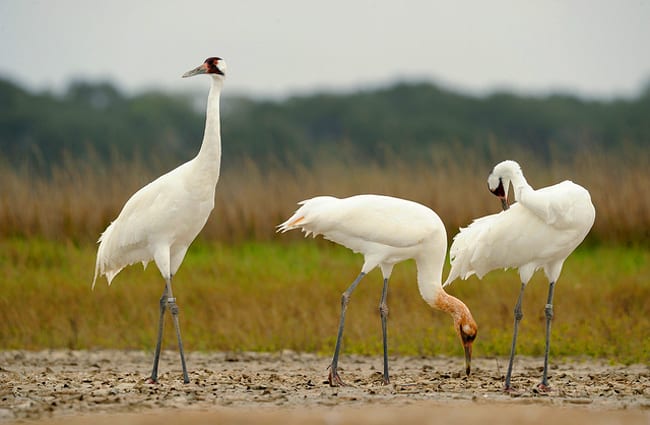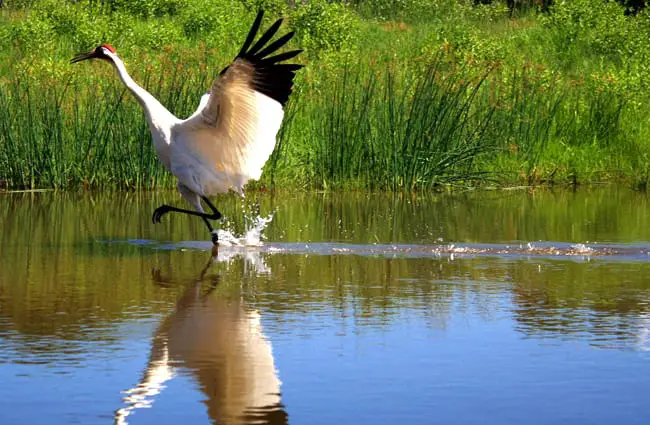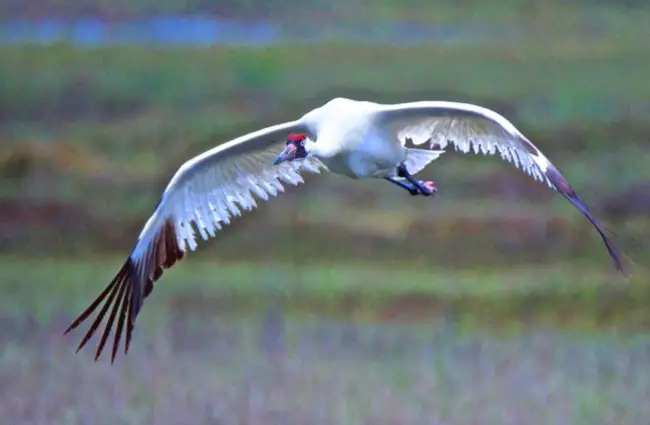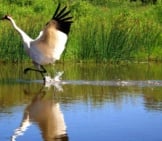Whooping cranes are large members of the Gruidae, or crane, family. They are the tallest bird in North America, standing nearly 5 ft. tall. This species is named for its whooping vocalization, which is quite loud and used to defend and announce territory.
These endangered birds are currently threatened by illegal hunting and habitat destruction. Their population is estimated to be at 800 birds total. Read on to learn about the whooping crane.
Description of the Whooping Crane
Whooping cranes look similar to a taller version of the sandhill crane. They stand nearly 5 ft. tall, and can weigh up to 16 lbs. on average. Like sandhills, they have a red patch of feathers on their foreheads, though it is slightly smaller than the sandhill crane’s.
The primary distinguishing characteristic between the two species is their plumage color. Sandhill cranes have grey/brown colored plumage, while whooping cranes are white.
Interesting Facts About the Whooping Crane
These endangered birds are currently battling for survival. There are a number of different initiatives and conservation plans in place to save these birds. Learn what makes them unique below.
- Wetland Living – One characteristic that helps these birds survive in a wetland environment is a reduced rear toe. This keeps their feet from getting tangled in the vegetation, which can potentially inhibit them from escaping predators. A shorter rear toe allows them to move through the wetlands easily and without getting tangled.
- Terrestrial Birds – This shorter toe also keeps them from roosting in trees like other bird species. Because they cannot land on trees, they are mostly terrestrial birds. Unlike some large terrestrial species, they can fly and use their large wings to migrate seasonally to their breeding grounds.
- Migration Patterns – During this migration birds do not accumulate into large numbers. While many of them are leaving around the same time, and travelling to the same place, they still remain in small groups. Scientists believe this helps them avoid predators, and reduces competition for food.
- Blue Crab Folly – Speaking of competition for food, these birds rely heavily on specific food sources to survive the strenuous migration to their breeding grounds. One of the most important food items on their diet is blue crabs. When blue crab populations decline, or they are overfished, the cranes suffer. Low crab population in the year 2000 led to a reduced reproductive rate for the whooping crane, while breeding in 2001.
Habitat of the Whooping Crane
These birds are not only restricted to a very small range, but they are also restricted to little suitable habitat as well. They nest and forage in marshes, wetlands, and near lakes. They rely heavily on these marshy habitats to provide foraging opportunities and nesting material.
Because they cannot perch in trees, this species nests on the ground. While nesting on the ground they must have open area without dense vegetation to provide optimum visibility for spotting predators.
Distribution of the Whooping Crane
Whooping cranes are restricted to two small populations. One population spends winters along the Gulf of Texas, particularly on the Aransas National Wildlife Refuge on the San Antonio Bay. During their migration, the Salt Plains National Wildlife Refuge in Oklahoma is an important stopover.
Stopovers allow the exhausted birds to feed and rest before continuing their journey. They nest in the Wood Buffalo National Park in Alberta Canada. A non-migratory population has also been introduced to Florida.
Diet of the Whooping Crane
These birds are omnivores, which means they feed on both plant and animal matter. Feeding behavior varies based on time of year, as birds that are nesting or preparing for migration require different nutritional needs.
Over winter in Texas they feed on blue crabs, clams, small fish, eels, reptiles, and aquatic plants. During the summer they feed on amphibians, small mammals, birds, fish, insects, crustaceans, berries, and aquatic plants.
Whooping Crane and Human Interaction
Humans decimated whooping crane populations directly via hunting, and indirectly via habitat destruction. Before European settlement of the United States it is estimated that there were well over 10,000 birds in the entire population. By 1938 a single population of 15 birds remained.
Conservation efforts were made to protect the remaining birds, and their habitat. Wild birds had a single egg removed, leaving them to care for only one chick, and the other egg was hatched in a zoological setting to create a captive breeding population.
Using a combination of artificial insemination and captive breeding, along with protections for the wild birds, the population has increased to 800 birds total, 161 of which are in captive breeding programs.
Domestication
These birds have not been domesticated in any way.
Does the Whooping Crane Make a Good Pet
It is highly illegal to own a whooping crane as a pet. They are endangered, and every individual is important for contributing to the survival of the species.
Whooping Crane Care
In a zoological setting these birds are carefully joined into compatible social pairs with the hopes of breeding being successful. They are provided with plenty of enclosure space to forage, and lots of low vegetation to allow adequate hiding places.
They are fed a varied diet that attempts to closely replicate their wild counterparts. Individuals that are destined to be returned to wild populations are fed by their parents with minimal human contact, or they are fed using crane puppets so they do not become habituated to humans.
Behavior of the Whooping Crane
Breeding pairs remain together, and will sometimes be accompanied by their offspring in small family groups. They defend a territory that includes their nest and foraging grounds.
Pairs protect this nest and territory from intruders, and use their loud whooping calls to announce their presence. When birds reach sexual maturity they use elaborate dances to choose an appropriate mate.
Reproduction of the Whooping Crane
Pairs of birds will build a nest on the ground, and most will build nests in the same territory as the year before. The female lays two eggs, and incubates them for approximately one month. If the eggs are lost or destroyed she will lay a new clutch.
Both parents take on the duties of incubation and chick rearing. It is rare for more than one chick to survive to fledging, and only half of the surviving chicks will make it through the winter migration.











![Red Angus Closeup of a beautiful Red Angus cowPhoto by: U.S. Department of Agriculture [pubic domain]https://creativecommons.org/licenses/by/2.0/](https://animals.net/wp-content/uploads/2020/03/Red-Angus-4-238x178.jpg)












![Red Angus Closeup of a beautiful Red Angus cowPhoto by: U.S. Department of Agriculture [pubic domain]https://creativecommons.org/licenses/by/2.0/](https://animals.net/wp-content/uploads/2020/03/Red-Angus-4-100x75.jpg)

